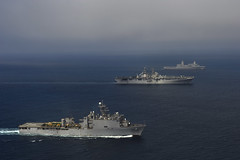The Chief of the Defence Force, General David Hurley, has co-chaired the second round of the Pakistan – Australia 1.5 Track Security Dialogue with Pakistan’s Chairman of the Joint Chiefs of Staff Committee, General Khalid Shameem Wynne, in Rawalpindi, Pakistan.
Last week’s Dialogue involved key security decision makers from a range of agencies, and selected think tank representatives, from Australia and Pakistan.
General Hurley said the Dialogue was an important mechanism for senior security decision-makers and strategists from Australia and Pakistan to share their perspectives on areas of critical importance to both countries.
“Australia is aware of the significant challenges posed by violent extremism in the border regions of Pakistan and Afghanistan, as well as the considerable price Pakistan has paid, and continues to pay,” General Hurley said.
Delegates discussed the security challenges facing Pakistan, and how Australia could assist Pakistan to address the threat posed by violent extremism. Discussion also focused on broader regional security with a particular emphasis on Afghanistan.
“Australia will continue to support Pakistan’s efforts to confront the challenges posed by extremism. Only concerted international cooperation and engagement will reduce the space in which such terrorists hide,” General Hurley said.
During the visit, General Hurley also met separately with Chief of Army Staff, General Kayani, Chief of Air Staff, Air Chief Marshal Rao Qamar Suleman, and Chief of Naval Staff, Admiral Muhammad Asif Sandila, to discuss Australia’s defence engagement with Pakistan.
General Hurley also had discussions on broader domestic and regional security matters with the Minister for Defence, Chaudry Ahmed Muhktar.
General Hurley thanked General Wynne for the hospitality shown to the Australian delegation throughout the visit.
“The Dialogue and meetings with senior Government figures and Pakistan military chiefs reflect both countries’ sincere desire to learn from each other’s experience and engage in a frank exchange of ideas on security matters,” General Hurley said.
Subsequent to the Dialogue, General Hurley offered his condolences to the Pakistan military and the families of the soldiers who were killed and wounded in the cross border incident on 26th November.

 Russia denies allegations over Indian T-90 tank contract
Russia denies allegations over Indian T-90 tank contract



























